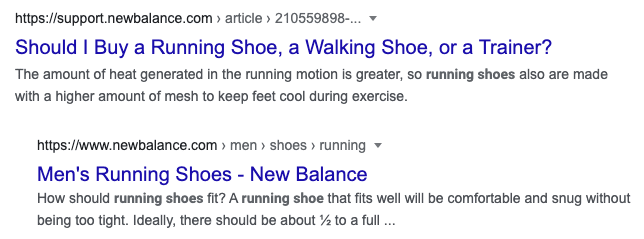If you’re seeing a sudden drop in your website’s search engine ranking, it may be due to a common SEO issue called keyword cannibalization.
But what is keyword cannibalization, and how do you fix it?
This post breaks down what cannibalization of keywords is and why it matters. Keep reading to discover how to identify and solve this web content problem.
What is keyword cannibalization?
Keyword cannibalization, or SEO cannibalism, occurs when multiple pages on your website compete for the same keyword or keyword phrases. This search engine optimization problem can lower search rankings and decrease traffic to your site.
More simply, cannibalization is when multiple pages on your website are optimized for the same search query, and you’re confusing search engines and your users by having various pieces of web content that target the same keyword.
For example, let’s say you run an orthopedics website and you’ve written two blog posts:
- “What Are the Most Common Causes Foot Pain?” (user intent: information gathering)
- “Foot Pain: 8 Reasons Why You Might Have Discomfort” (user intent: information gathering)
Each of these posts are written to help users trying to gather more information about the causes of foot pain. There is no differing user intent, so this hypothetical orthopedics blog essentially has two pieces of content competing against each other for that one keyword target.
When keyword cannibalization like this occurs, it can be terrible for SEO (resulting in lower rankings for both pages). It can also confuse your readers, too, who might see both pages in search results and not know which to click for the information they need since they both use the same keyword and have the same user intent.
If the marketing team running the hypothetical orthopedics blog wanted to have more than one post with the keyword target of “foot pain,” to do so successfully they would need to switch up the focus of the posts sharing this keyword so that each post had a distinctive and clear user intent, like this:
- “What Are the Most Common Causes Foot Pain?” (user intent: information gathering — for people trying to find out why they have foot pain)
- “How Weight Loss Helped One Man Lasting Find Relief for Foot Pain” (user intent: consideration — for people thinking about losing weight to eliminate foot pain)
Example of keyword cannibalization
New Balance, which has keyword-optimized product pages for their gear as well as a blog posts with keyword targets as a way to organically drive traffic to their website, is experiencing some instances of cannibalization with its website content.

If you do a Google search for “how to buy running shoes,” the SERP (above) will include two pages from New Balance’s website that have been optimized for the keyword phrase “running shoes.” The web copy on the pages shown by Google has a transactional focus, which is why Google presents the both options to its users. Having more than one choice covering the same topic makes it confusing for users who may not be sure which link will be the best to click through to for what they need.
For complex websites with lots of content, this type of tricky keyword cannibalization issue can happen a lot as new pages are created. One way to avoid a problem like this is to use more specific long-tail keyword variations as supporting pieces that point to a page which serves as a content hub.
“If you have multiple pieces of content that are ranking for the same query with the same intent, then you’re essentially kind of diluting the value of the content that you’re providing across multiple pages. They’re competing with each other. … [Unique keywords] is not something that we require or that is okay or not okay. It’s really a matter of kind of your strategic positioning and how you want to appear in search.”
John Mueller, Google search advocate
How to tell if your website content has SEO issues
There are a few ways to diagnose a keyword cannibalization issue with your web content.
First, check out your website analytics to see if any formerly ranking pages have dipped in web traffic. If you notice a drop in web traffic to specific pages, the reason may be due to SEO cannibalization.
Another way to diagnose if cannibalization exists is to look at your website’s overall search engine ranking. If you notice that your site’s ranking has dropped for specific keywords, this too could be due to keyword cannibalization.
Finally, you can use a keyword research tool to see if multiple pages on your website compete for the same keywords. If you find numerous web pages competing for identical keywords, you may have a cannibalization issue with your site’s content.

Use this tool to start planning a new website that will drive long-term digital marketing success.
Signs of keyword cannibalization problems
There are a variety of symptoms related to website performance that you might have SEO cannibalization issues caused by keyword use in your content.
You may notice that your website’s search ranking drops for specific key phrases or that your Google rankings for different pages are constantly fluctuating. This may be because the search engine can’t determine which of your pages should rank. Dueling keyword targets create confusing signals which hurt page rankings.
Another sign of keyword cannibalization that sometimes appears is a decrease in traffic for specific pages or having multiple web pages on your site show up in SERPs for the same keyword.
If you notice any of these signs of trouble with keyword rankings, SEO cannibalization could be the cause.
How to fix keyword cannibalization
To ensure that your website can achieve its full potential in search, you can take steps to spot critical SEO issues (including unintentional keyword stuffing or duplicate keyword targeting) and make appropriate content adjustments.
- Identify any pages on your site competing for the same keyword.
- Evaluate each page to see if it’s vital. Is there a way to consolidate or eliminate some of the pages?
- Make sure each page targets a different keyword (or keyword phrase).
- If your site has duplicate content, make sure to use canonical tags to specify the correct version of the page.
- Use keyword research tools to decide which keywords to target on each page.
- Monitor your website’s search engine ranking to ensure that SEO cannibalization is not negatively impacting your site’s performance.
Tools for identifying and correcting keyword cannibalization issues
Keyword cannibalization can be a complex problem to solve, but there are solutions available that can make the process easier. The following is a list of some of our favorite resources. They can help you identify any significant keyword cannibalization issues on your website.
Screaming Frog: This web crawler can be used to identify duplicate content on your site quickly.
Google Search Console: This tool can help you find pages competing for the identical keywords on your site.
Moz Keyword Explorer: This keyword research tool can help you determine which keywords to target on each page.
Track Keyword Rankings: This rank tracking tool can monitor your website’s search engine ranking and ensure that SEO cannibalization is not negatively impacting your site’s performance.
If you’re having trouble fixing keyword cannibalization issues on your own, consider working with a reputable digital marketing agency—like TBH Creative—that has a staff with experience helping clients improve SEO.
Track your website’s SEO progress after making changes
Keeping an eye on your rankings and addressing any new SEO issues early on helps ensure that your site keeps on ranking well in search results.
You can use ranking tools to ensure that your fixes to reduce keyword cannibalization issues on your site are working because your content is starting to rank better in search results.
By monitoring your keyword strategy and making adjustments as needed, you can help avoid keyword cannibalization issues on your website and improve your overall SEO.
How can you avoid keyword cannibalization issues?
The easiest way to prevent cannibalization is to have an SEO strategy for your website. Creating and maintaining a method for optimizing your web content ensures that your site gets the best possible results.
If you aren’t seeing any keyword cannibalization issues on your site, you can take steps to prevent having to deal with this time-consuming problem in the future.
- Create a keyword strategy and write high-quality new content. Remember user intent and focus on using various keyword phrases instead of just one or two over and over for all of your content.
- Use keyword research tools to help you find new keyword ideas that you can target. Staying on top of keyword mapping is a great way to make sure each piece of new content you create for your website targets a different keyword.
- Track your keyword rankings to see which keywords are being used most often. Use a resource like Google Analytics to monitor this data.
- Optimize your web content for specific keyword phrases. Write so that each piece of content is focused on a different keyword phrase so that you’re not competing with yourself.
- Run regular website content audits. Take this proactive step to reduce SEO cannibalization issues and ensure your content performs as well as possible.
What is user intent in SEO?
User intent, also sometimes referred to as keyword intent or search intent, is why someone performs a Google search. Understanding user intent is crucial for SEO because it helps you create the content that searchers are looking for, which can help your website rank higher in search results. The four types include:
Navigational: The user types in the URL or part of the URL into the search bar because they want to pull up a specific webpage.
Informational: The user is looking for info on a topic and wants to learn more about it.
Transactional: The user is interested in buying something and wants to find the best option available.
Commercial investigation: The user is comparison shopping and wants to find the best product or service to meet their needs.
If you’re struggling with determining user intent or diagnosing keyword cannibalization problems, contact an SEO expert at a trusted digital marketing agency, like TBH Creative, for help getting a handle on the situation. They can help you figure out which keyword phrases to target and how to optimize your website content to rank well in search engines.
Frequently asked questions about SEO cannibalization
Is keyword cannibalization real?
Cannibalization of keywords does happen, and it can hurt your website’s SEO. If you have multiple pages on your site that are optimized for the same keyword phrase, you’re competing with yourself, and it can result in multiple pages from your website ranking poorly.
Why does keyword cannibalization matter?
Cannibalization matters for many reasons, but user experience and search engine rankings are top.
If you have multiple pieces of content ranking for the same keyword, you’re essentially competing with yourself, resulting in all pages ranking more poorly. Consider this: if you have two pages with the same keyword target and one converts better than the other, what happens if—because it’s confused by conflicting signals—Google ranks the less effective page higher on SERPs.
Fixing keyword cannibalization problems can help you avoid splitting your authority for different high-volume key terms over several pieces of web content.
Beyond these significant search engine issues, problems caused by repeated keyword use can also confuse readers who land on your site (and perplexed, unhappy users don’t convert).
Should I use the same keywords on every page?
If you’re worried about keyword cannibalization, you might be wondering if you should avoid using the same keyword on multiple pages. The answer is: it depends.
If you have a simple website with just a few pages, it’s probably unnecessary to stress over cannibalization-related issues. However, keyword cannibalization could be a problem if you have a large website with hundreds or thousands of pages.
What is keyword stemming in website SEO?
Keyword stemming is the process of finding different forms of a keyword. For example, if you’re optimizing an e-commerce website for the keyword “athletic towels,” you might also want to target related keywords like “sweat towels,” “fitness towels,” “workout towels,” “gym towels,” “football towels,” etc.
What is keyword stuffing?
Cramming a keyword or phrase into your website content—as many times as possible—in an attempt to rank higher in search results pages is known as keyword stuffing.
This used to be an effective SEO tactic, but it will do more harm than good today. Keyword stuffing makes your content difficult to read and triggers Google’s spam filters, resulting in lower rankings.
What is content pruning?
Content pruning is the process that involves removing old and outdated content from your website. It is essential for two reasons: first, it will help improve your site’s overall quality; second, it is one way to help prevent keyword cannibalization.
If you have multiple pages on your site that are optimized for the same keyword, you should consider pruning the weaker piece of content. This will help avoid SEO cannibalization and ensure that only your best content ranks in search results.
How many keywords are good for SEO? How many keywords per page is too many?
When it comes to keywords per webpage, there is no magic number you should use. However, it is best to focus on a small number of targeted keywords per page as a general rule. This tactic will help to ensure that your content is relevant and keyword-rich without being keyword-stuffed or contributing to keyword cannibalism issues.
What are LSI keywords? Why do they matter?
LSI keywords (which are also known as latent semantic indexing keywords) are related terms often used as synonyms or related phrases to your primary keyword.
Using LSI keywords in your content can help to improve your keyword density and make your content more relevant to search engines. They also enhance keyword density, which is another critical factor for SEO, and help search engines understand the context of your content.
How can I find LSI keywords?
When you are fixing keyword cannibalization issues with your website content, here are two things you can do to find LSI keywords when optimizing your web copy:
- Use Google’s related searches feature. Enter your main keyword into Google and scroll down to the “Searches related to” section at the bottom of the page. These are all potential LSI keywords that you can use in your content.
- Use a keyword research tool. Several keyword research and planning tools are available, such as Google Keyword Planner, SEMrush, and KWFinder. These options will give you a list of LSI keywords and provide data on keyword difficulty and search volume.
Improve search rankings by resolving keyword cannibalization problems
Now that you know how SEO cannibalization can impact your website’s search engine rankings, it’s time to clean up your website content. Have you checked for keyword cannibalization on your website?
If you need help getting started, TBH Creative is here to help. We’re pros at improving your website search engine visibility by diagnosing and fixing SEO issues of all kinds.

